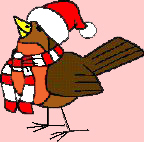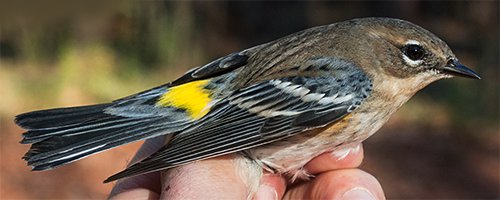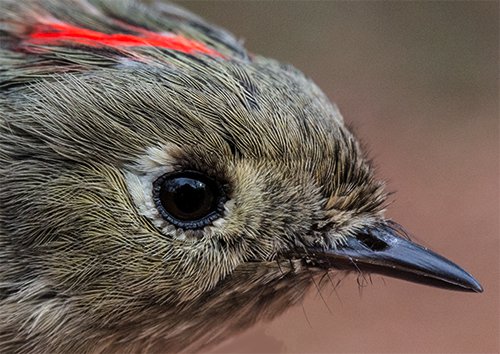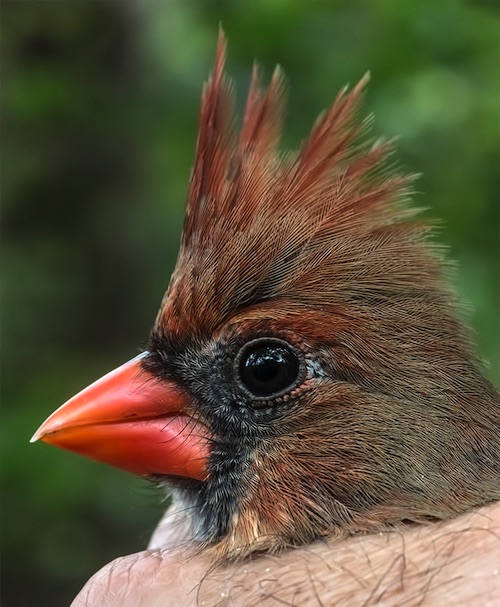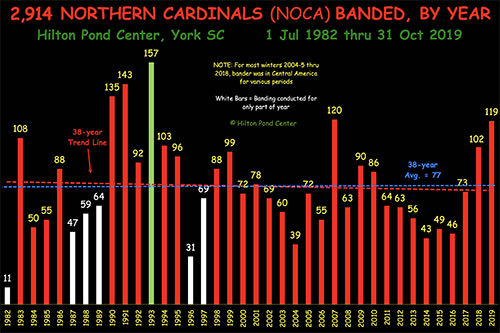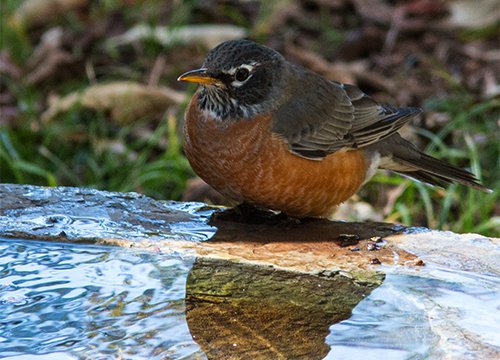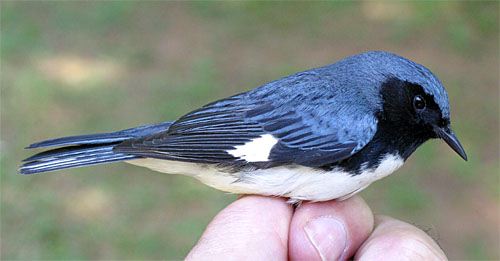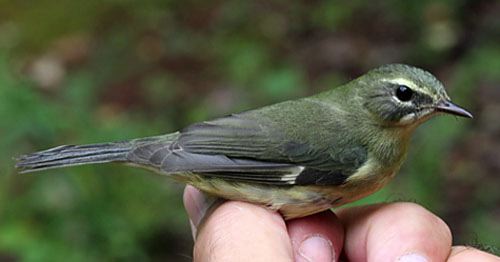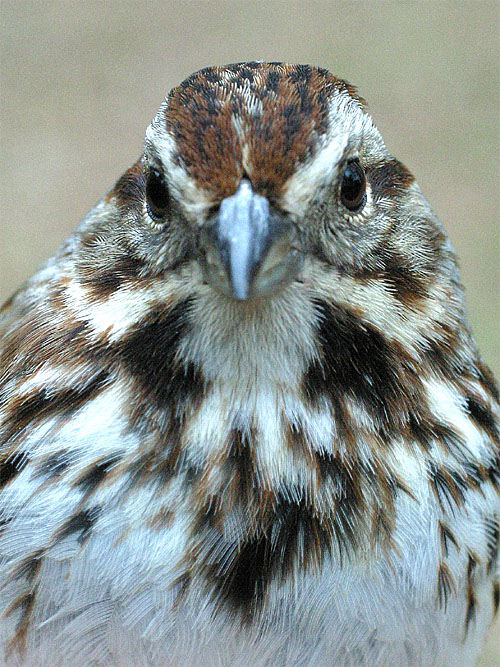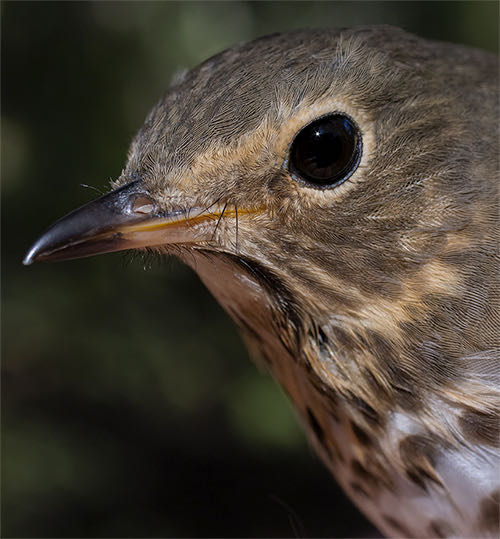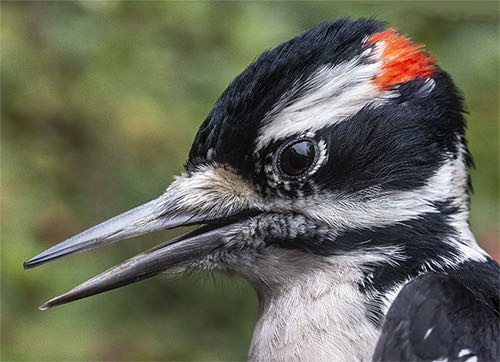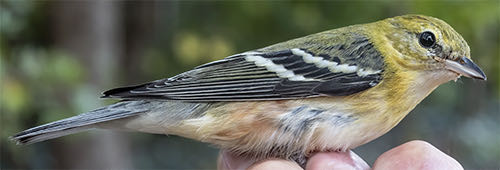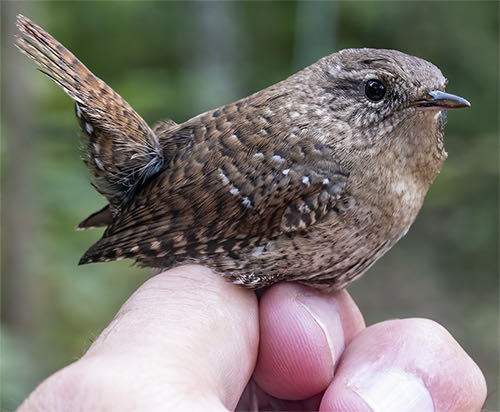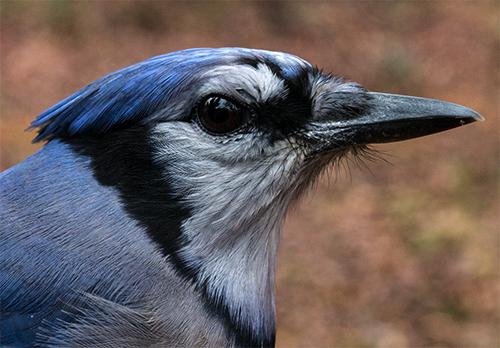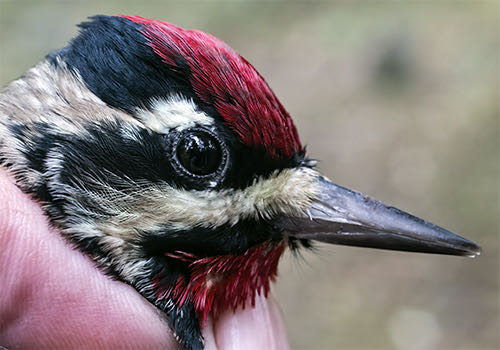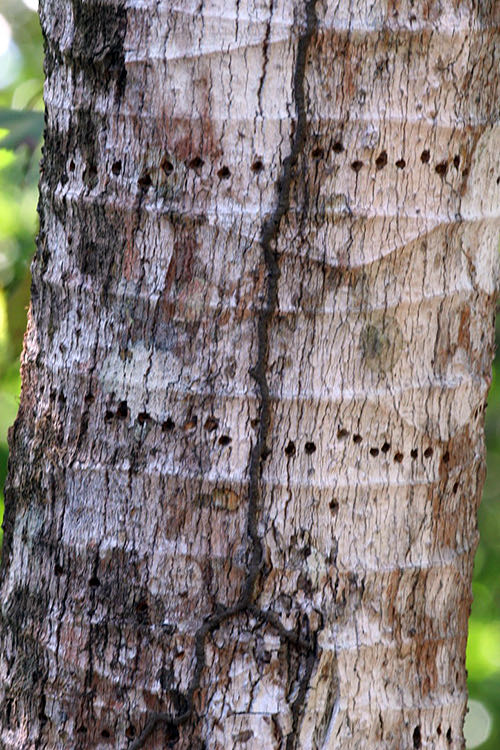- Established 1982 -HOME: www.hiltonpond.org
THIS WEEK at HILTON POND Subscribe for free to our award-winning nature newsletter (Back to Preceding Week; on to Next Week) |
Join Us for the |
|
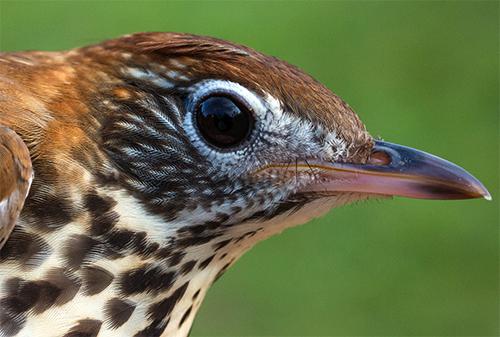
All text, maps, charts & photos © Hilton Pond Center LATE OCTOBER
BIRD MIGRATION: As October 2019 progressed, Hilton Pond Center saw fewer and fewer Neotropical migrant birds, i.e., those that breed in North America and spend our winter months in Latin America. Local summer resident neotrops like spot-breasted Wood Thrushes (above), Gray Catbirds, and Acadian Flycatchers began disappearing, while species that nest in Canada--especially warblers and thrushes--came through early in the month and dwindled to near zero by Halloween. In fact, during the first half of October we banded 38 birds of 14 Neotropical species, but from the 16th through the 31st only ten neotrops from three species hit our mist nets. (We might have caught even more birds early in the month had it not been for that unavoidable ruckus caused by roof, deck, and gutter work on the Center's old farmhouse.)
All text, maps, charts & photos © Hilton Pond Center Interestingly, the latter half of the month also saw a local influx of Canadian (or Appalachian) breeders that typically come only as far as southeastern states to spend a relatively balmy winter: Yellow-rumped Warbler (above), White-throated Sparrow, Hermit Thrush, Yellow-bellied Sapsucker, Winter Wren, and Ruby-crowned Kinglet (male, below).
All text, maps, charts & photos © Hilton Pond Center With all these overlapping avian movements in mind, "This Week at Hilton Pond" we take a look at some of our banding captures during the last half of October--both Neotropical pass-throughs and winter residents.
All text, maps, charts & photos © Hilton Pond Center After two-plus weeks of intensive work on the Hilton Pond Center's old farmhouse, it was time on 21 October to once again open our mist nets. This proved to be quite productive, getting us 24 individuals from seven species (list below). 1 Carolina Chickadee The most startling result was those 13 new Northern Cardinals (NOCA) in one day, suggesting there must be a redbird factory somewhere nearby! The current influx of NOCA (female above) at the Center continued during the last fortnight of October with a two-week total of 28 banded--following 15 from the first half of the month. Nearly all those 43 NOCA in the just-completed month were young-of-the-year, indicating a pretty good Northern Cardinal breeding season.
All text, maps, charts & photos © Hilton Pond Center Through October, that's 119 Northern Cardinals banded in 2019--our fifth best year since 1982. (See chart above. Our NOCA record is 157 from 1993--perhaps within reach at the current rate.) We take this recent cardinal resurgence as a good sign, considering much smaller numbers occurred many years at the Center from about the mid-1990s onward.
All text, maps, charts & photos © Hilton Pond Center The two "butterbutts" (Yellow-rumped Warblers) this week were our first of the season. As we banded them a small flock of American Robins was fluttering about, visiting a water feature to bathe and drink (above) while making short work of our Flowering Dogwoods--stripping every twig of its bounty of scarlet berries (below). The back deck of the old farmhouse was littered with dogwood seeds expelled soon after the birds' fast-acting digestive tracts absorbed whatever nutrients might be in the pulp.
All text, maps, charts & photos © Hilton Pond Center Of particular note this week were three Black-throated Blue Warblers (BTBW), if only because we caught two females and a male that allowed for comparison. Among Wood Warblers (Parulidae), BTBW have the greatest degree of external sexual dimorphism, sharing only one noticeable characteristic. In fact, the genders are so different in appearance that early North American ornithologists from Alexander Wilson to John James Audubon considered them to be separate species!
All text, maps, charts & photos © Hilton Pond Center The male Black-throated Blue Warbler (above) has striking slate-blue plumage and a black mask, while the female (below) is mostly dark yellow-green with a white superciliary line. Study the two photos and you can probably figure out what field mark they DO have in common.
All text, maps, charts & photos © Hilton Pond Center Give up? It's the white wing patch--very obvious in the male but sometimes quite tiny in females. If you see a greenish-yellow warbler in fall you can't identify, look for that white spot halfway down the folded wing and you'll know you're watching a female Black-throated Blue Warbler like the one above from Hilton Pond Center. All text, maps, charts & photos © Hilton Pond Center
All text, maps, charts & photos © Hilton Pond Center We had nine mist nets deployed at the Center before 8 a.m. on the morning of 23 October and within 15 minutes had our hands full. Here's the tally from just the first net check at 8:10! 10 American Robins (see photo above; likely male with dark head) Oddly, after those 15 bandings we caught only two more birds--both cardinals--in ten hours before shutting down at dusk. Hard to explain.
All text, maps, charts & photos © Hilton Pond Center Folks are often surprised when we report the fall season's first Song Sparrow (SOSP, above, with central breast spot), one of the most common of all North American sparrow species. Nonetheless, for SOSP the southeastern edge of the breeding range almost seems to stop at the Broad River just west of us on the border of the Center's home county of York. We have very few summer records out of 463 SOSP banded, and in 38 years here have never found a local nest or captured either a recent fledgling or a breeding female Song Sparrow with a brood patch. (That said, we wouldn't be surprised if some sharp-eyed observer has seen summering Song Sparrows in Fort Mill or Rock Hill SC, just 10 miles east of us--and maybe even knows of a nearby nest. If so, let is know at RESEARCH.)
All text, maps, charts & photos © Hilton Pond Center One LBJ ("Little Brown Jobber") we'd never expect to see in York County during the breeding season is the White-throated Sparrow (WTSP), which breeds almost exclusively in Canada (barely into New England the the Great Lakes States). Our earliest-ever in autumn at the Center is 4 October, while a spring individual was very late departing on 27 May. One exceptional WTSP we banded at Hilton Pond on 15 April 1990 showed up just 15 days later in Lake à la Ligne, Quebec--970 miles away--only to be killed by a free-roaming cat! White-throated Sparrows come in two morphs--dull and bright. The one in the photo above is the latter, although even dull morph WTSP have at least a hint of yellow on the lores.
All text, maps, charts & photos © Hilton Pond Center We got a "red flag" when we first tried to report to eBird a Swainson's Thrush (SWTH, see photo above) we banded at Hilton Pond Center on 25 October, apparently because eBird's historical record suggests this buffy-faced Neotropical migrant should be gone from the Carolina Piedmont by that date. (Two SWTH we reported just two days previous on the 23rd did not warrant a similar "rejection," but you might guess two banded even later on 28 October really got eBird's attention!) The Center's previous late record for SWTH was 25 Oct 1994, although McNair & Post (1993) cite an extremely late one on 20 November 1990 in Anderson County SC. All text, maps, charts & photos © Hilton Pond Center
All text, maps, charts & photos © Hilton Pond Center We only caught 11 birds of eight species on 25 October 2019, but three of those are worth mention because they have been banded rarely at Hilton Pond Center during our 38 years here: 1 Winter Wren (15th in 38 years) We really like members of the Picidae, so the male Hairy Woodpecker (photo above; our 38th since 1982) was a treat to hold--albeit we had to be careful not to get pecked. (We also banded a male Red-bellied Woodpecker and recaptured two banded Downy Woodpeckers, all while a couple of Pileated Woodpeckers tore up a dead branch high above our mist nets. Jackhammer heaven!)
All text, maps, charts & photos © Hilton Pond Center A locally uncommon Bay-breasted Warbler (above) was great to see this week, especially since was only our 17th of its species banded locally since 1982. This particular immature male had only a hint of "bay" on his lower flanks and will look very different when he acquires his full breeding attire.
All text, maps, charts & photos © Hilton Pond Center Even though Hairy Woodpeckers and Bay-breasted Warblers are both rare at Hilton Pond Center, our "Bird of the Day" on 25 October had to be a diminutive Winter Wren--its short tail (above) cocked high in characteristic pose. This tiny member of the Trogodytidae seems barely half the size of our big lunker Carolina Wren, so the photo above includes more of the bander's fingers than usual to give a sense of scale. As its name implies, the Winter Wren appears in the Carolina Piedmont only during colder months, having spent the breeding season in New England and much of Canada. (CAVEAT: There's also a population that breeds at high elevations down the Appalachians into North Carolina.) On his breeding grounds, the male Winter Wren is an energetic master builder that constructs several nests to which he leads a prospective mate. If she "likes" what she sees, she chooses one, mates with the male, and moves into the home that met her instinctive standards. The one we netted on 25 October was just our 15th WIWR; curiously, we caught another--in a trap baited with sunflower seeds--five days later. All text, maps, charts & photos © Hilton Pond Center
All text, maps, charts & photos © Hilton Pond Center We didn't run nets on 27 October because of much-needed overnight and morning rains, all accompanied by gusty winds that continued until early afternoon. The following day yielded sparse results for our banding efforts, with only nine individuals of five species captured--and none of them could really be considered "Neotropical": 3 Yellow-rumped Warblers
All text, maps, charts & photos © Hilton Pond Center Even so, it was a good week for woodpeckers, including our first Yellow-bellied Sapsucker (YBSA) of the season (above). This colorful member of the Picidae was a hatch-year male--females don't have the red chin--and like most woodpeckers he was quite vocal in-hand. He also scratched pretty well, using strong toes and sharp, decurved claws to inflict superficial wounds on the bander's hands.
All text, maps, charts & photos © Hilton Pond Center Despite its name, observers seldom see a Yellow-bellied Sapsucker's pale lemon-yellow underside (above) that stays tight against tree trunks as the bird forages. This week's individual had particularly bright and lustrous plumage, a sure sign he was well-fed and likely to survive the winter unless taken by a Cooper's Hawk or some other avian predator.
All text, maps, charts & photos © Hilton Pond Center Yellow-bellied Sapsuckers breed from New England across Canada and into eastern Alaska but move south come winter. (A few breed at high elevations in the mountains of North Carolina and the Virginias.) Interestingly, some Yellow-bellied Sapsuckers actually ARE Neotropical migrants that end up as far south as western Panama; in fact, we were quite surprised one January in Costa Rica during an Operation RubyThroat expedition to find Cecropia trees (above) riddled with those familiar horizontal rows of quarter-inch holes made by this sap-feeding species Who would have expected a woodpecker hatched in Canada's boreal woodlands to end up in tropical dry forests of Guanacaste Province, Costa Rica? We doubt the Yellow-bellied Sapsucker we banded this week--just our 48th locally since 1982--will be going to faraway Central America. After all, we have a dependable sap-making Pecan tree in Hilton Pond Center's front yard that has hosted hungry sapsuckers every winter for at least 38 years. No need to fly to the land of Cecropias when local fare will do. All text, maps, charts & photos © Hilton Pond Center
Checks also can be sent to Hilton Pond Center at: All contributions are tax-deductible on your Don't forget to scroll down for Nature Notes & Photos, |
|---|
|
"This Week at Hilton Pond" is written and photographed by Bill Hilton Jr., executive director of Hilton Pond Center for Piedmont Natural History
|
|
|
Please refer "This Week at Hilton Pond" to others by clicking on this button: |
|

